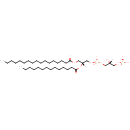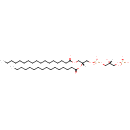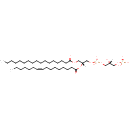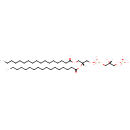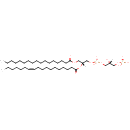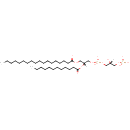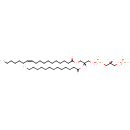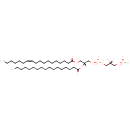
Search Results for compounds
Searching compounds for
returned 4373 results.
Displaying compounds 2471 - 2480 of
4373 in total
PGP(17:0/14:0) (PAMDB006415)
IUPAC:
[(2R)-3-({[(2R)-3-(heptadecanoyloxy)-2-(tetradecanoyloxy)propoxy](hydroxy)phosphoryl}oxy)-2-hydroxypropoxy]phosphonic acid
CAS: Not Available
Description: PGP(17:0/14:0) belongs to the class of glycerophosphoglycerophosphates, also called phosphatidylglycerophosphates (PGPs). These lipids contain a common glycerophosphate skeleton linked to at least one fatty acyl chain and a glycero-3-phosphate moiety. As is the case with diacylglycerols, phosphatidylglycerophosphates can have many different combinations of fatty acids of varying lengths and saturation attached to the C-1 and C-2 positions. PGP(17:0/14:0), in particular, consists of one heptadecanoyl chain to the C-1 atom, and one tetradecanoyl to the C-2 atom. In Pseudomonas aeruginosa, PGPs can be found in the cytoplasmic membrane. The are synthesized by the addition of glycerol 3-phosphate to a CDP-diacylglycerol. In turn, PGPs are dephosphorylated to Phosphatidylglycerols (PGs) by the enzyme Phosphatidylglycerophosphatase.
PGP(17:0/16:0) (PAMDB006416)
IUPAC:
[(2R)-3-({[(2R)-3-(heptadecanoyloxy)-2-(hexadecanoyloxy)propoxy](hydroxy)phosphoryl}oxy)-2-hydroxypropoxy]phosphonic acid
CAS: Not Available
Description: PGP(17:0/16:0) belongs to the class of glycerophosphoglycerophosphates, also called phosphatidylglycerophosphates (PGPs). These lipids contain a common glycerophosphate skeleton linked to at least one fatty acyl chain and a glycero-3-phosphate moiety. As is the case with diacylglycerols, phosphatidylglycerophosphates can have many different combinations of fatty acids of varying lengths and saturation attached to the C-1 and C-2 positions. PGP(17:0/16:0), in particular, consists of one heptadecanoyl chain to the C-1 atom, and one hexadecanoyl to the C-2 atom. In Pseudomonas aeruginosa, PGPs can be found in the cytoplasmic membrane. The are synthesized by the addition of glycerol 3-phosphate to a CDP-diacylglycerol. In turn, PGPs are dephosphorylated to Phosphatidylglycerols (PGs) by the enzyme Phosphatidylglycerophosphatase.
PGP(17:0/16:1(9Z)) (PAMDB006417)
IUPAC:
[(2R)-3-({[(2R)-3-(heptadecanoyloxy)-2-[(9Z)-hexadec-9-enoyloxy]propoxy](hydroxy)phosphoryl}oxy)-2-hydroxypropoxy]phosphonic acid
CAS: Not Available
Description: PGP(17:0/16:1(9Z)) belongs to the class of glycerophosphoglycerophosphates, also called phosphatidylglycerophosphates (PGPs). These lipids contain a common glycerophosphate skeleton linked to at least one fatty acyl chain and a glycero-3-phosphate moiety. As is the case with diacylglycerols, phosphatidylglycerophosphates can have many different combinations of fatty acids of varying lengths and saturation attached to the C-1 and C-2 positions. PGP(17:0/16:1(9Z)), in particular, consists of one heptadecanoyl chain to the C-1 atom, and one 9Z-hexadecenoyl to the C-2 atom. In Pseudomonas aeruginosa, PGPs can be found in the cytoplasmic membrane. The are synthesized by the addition of glycerol 3-phosphate to a CDP-diacylglycerol. In turn, PGPs are dephosphorylated to Phosphatidylglycerols (PGs) by the enzyme Phosphatidylglycerophosphatase.
PGP(17:0/17:0) (PAMDB006418)
IUPAC:
[(2R)-3-({[(2R)-2,3-bis(heptadecanoyloxy)propoxy](hydroxy)phosphoryl}oxy)-2-hydroxypropoxy]phosphonic acid
CAS: Not Available
Description: PGP(17:0/17:0) belongs to the class of glycerophosphoglycerophosphates, also called phosphatidylglycerophosphates (PGPs). These lipids contain a common glycerophosphate skeleton linked to at least one fatty acyl chain and a glycero-3-phosphate moiety. As is the case with diacylglycerols, phosphatidylglycerophosphates can have many different combinations of fatty acids of varying lengths and saturation attached to the C-1 and C-2 positions. PGP(17:0/17:0), in particular, consists of two heptadecanoyl chains at positions C-1 and C-2. In Pseudomonas aeruginosa, PGPs can be found in the cytoplasmic membrane. The are synthesized by the addition of glycerol 3-phosphate to a CDP-diacylglycerol. In turn, PGPs are dephosphorylated to Phosphatidylglycerols (PGs) by the enzyme Phosphatidylglycerophosphatase.
PGP(17:0/18:1(11Z)) (PAMDB006419)
IUPAC:
[(2R)-3-({[(2R)-3-(heptadecanoyloxy)-2-[(11Z)-octadec-11-enoyloxy]propoxy](hydroxy)phosphoryl}oxy)-2-hydroxypropoxy]phosphonic acid
CAS: Not Available
Description: PGP(17:0/18:1(11Z)) belongs to the class of glycerophosphoglycerophosphates, also called phosphatidylglycerophosphates (PGPs). These lipids contain a common glycerophosphate skeleton linked to at least one fatty acyl chain and a glycero-3-phosphate moiety. As is the case with diacylglycerols, phosphatidylglycerophosphates can have many different combinations of fatty acids of varying lengths and saturation attached to the C-1 and C-2 positions. PGP(17:0/18:1(11Z)), in particular, consists of one heptadecanoyl chain to the C-1 atom, and one 11Z-octadecenoyl to the C-2 atom. In Pseudomonas aeruginosa, PGPs can be found in the cytoplasmic membrane. The are synthesized by the addition of glycerol 3-phosphate to a CDP-diacylglycerol. In turn, PGPs are dephosphorylated to Phosphatidylglycerols (PGs) by the enzyme Phosphatidylglycerophosphatase.
PGP(17:0/19:0) (PAMDB006420)
IUPAC:
[(2R)-3-({[(2R)-3-(heptadecanoyloxy)-2-(nonadecanoyloxy)propoxy](hydroxy)phosphoryl}oxy)-2-hydroxypropoxy]phosphonic acid
CAS: Not Available
Description: PGP(17:0/19:0) belongs to the class of glycerophosphoglycerophosphates, also called phosphatidylglycerophosphates (PGPs). These lipids contain a common glycerophosphate skeleton linked to at least one fatty acyl chain and a glycero-3-phosphate moiety. As is the case with diacylglycerols, phosphatidylglycerophosphates can have many different combinations of fatty acids of varying lengths and saturation attached to the C-1 and C-2 positions. PGP(17:0/19:0), in particular, consists of one heptadecanoyl chain to the C-1 atom, and one nonadecanoyl to the C-2 atom. In Pseudomonas aeruginosa, PGPs can be found in the cytoplasmic membrane. The are synthesized by the addition of glycerol 3-phosphate to a CDP-diacylglycerol. In turn, PGPs are dephosphorylated to Phosphatidylglycerols (PGs) by the enzyme Phosphatidylglycerophosphatase.
PGP(18:0/12:0) (PAMDB006421)
IUPAC:
[(2R)-3-({[(2R)-2-(dodecanoyloxy)-3-(octadecanoyloxy)propoxy](hydroxy)phosphoryl}oxy)-2-hydroxypropoxy]phosphonic acid
CAS: Not Available
Description: PGP(18:0/12:0) belongs to the class of glycerophosphoglycerophosphates, also called phosphatidylglycerophosphates (PGPs). These lipids contain a common glycerophosphate skeleton linked to at least one fatty acyl chain and a glycero-3-phosphate moiety. As is the case with diacylglycerols, phosphatidylglycerophosphates can have many different combinations of fatty acids of varying lengths and saturation attached to the C-1 and C-2 positions. PGP(18:0/12:0), in particular, consists of one octadecanoyl chain to the C-1 atom, and one dodecanoyl to the C-2 atom. In Pseudomonas aeruginosa, PGPs can be found in the cytoplasmic membrane. The are synthesized by the addition of glycerol 3-phosphate to a CDP-diacylglycerol. In turn, PGPs are dephosphorylated to Phosphatidylglycerols (PGs) by the enzyme Phosphatidylglycerophosphatase.
PGP(18:0/18:1(9Z)) (PAMDB006425)
IUPAC:
[(2R)-2-hydroxy-3-({hydroxy[(2R)-2-[(9Z)-octadec-9-enoyloxy]-3-(octadecanoyloxy)propoxy]phosphoryl}oxy)propoxy]phosphonic acid
CAS: Not Available
Description: PGP(18:0/18:1(9Z)) belongs to the class of glycerophosphoglycerophosphates, also called phosphatidylglycerophosphates (PGPs). These lipids contain a common glycerophosphate skeleton linked to at least one fatty acyl chain and a glycero-3-phosphate moiety. As is the case with diacylglycerols, phosphatidylglycerophosphates can have many different combinations of fatty acids of varying lengths and saturation attached to the C-1 and C-2 positions. PGP(18:0/18:1(9Z)), in particular, consists of one octadecanoyl chain to the C-1 atom, and one 9Z-octadecenoyl to the C-2 atom. In Pseudomonas aeruginosa, PGPs can be found in the cytoplasmic membrane. The are synthesized by the addition of glycerol 3-phosphate to a CDP-diacylglycerol. In turn, PGPs are dephosphorylated to Phosphatidylglycerols (PGs) by the enzyme Phosphatidylglycerophosphatase.
PGP(18:1(11Z)/14:0) (PAMDB006426)
IUPAC:
[(2R)-2-hydroxy-3-({hydroxy[(2R)-3-[(11Z)-octadec-11-enoyloxy]-2-(tetradecanoyloxy)propoxy]phosphoryl}oxy)propoxy]phosphonic acid
CAS: Not Available
Description: PGP(18:1(11Z)/14:0) belongs to the class of glycerophosphoglycerophosphates, also called phosphatidylglycerophosphates (PGPs). These lipids contain a common glycerophosphate skeleton linked to at least one fatty acyl chain and a glycero-3-phosphate moiety. As is the case with diacylglycerols, phosphatidylglycerophosphates can have many different combinations of fatty acids of varying lengths and saturation attached to the C-1 and C-2 positions. PGP(18:1(11Z)/14:0), in particular, consists of one 11Z-octadecenoyl chain to the C-1 atom, and one tetradecanoyl to the C-2 atom. In Pseudomonas aeruginosa, PGPs can be found in the cytoplasmic membrane. The are synthesized by the addition of glycerol 3-phosphate to a CDP-diacylglycerol. In turn, PGPs are dephosphorylated to Phosphatidylglycerols (PGs) by the enzyme Phosphatidylglycerophosphatase.
PGP(18:1(11Z)/17:0) (PAMDB006427)
IUPAC:
[(2R)-3-({[(2R)-2-(heptadecanoyloxy)-3-[(11Z)-octadec-11-enoyloxy]propoxy](hydroxy)phosphoryl}oxy)-2-hydroxypropoxy]phosphonic acid
CAS: Not Available
Description: PGP(18:1(11Z)/17:0) belongs to the class of glycerophosphoglycerophosphates, also called phosphatidylglycerophosphates (PGPs). These lipids contain a common glycerophosphate skeleton linked to at least one fatty acyl chain and a glycero-3-phosphate moiety. As is the case with diacylglycerols, phosphatidylglycerophosphates can have many different combinations of fatty acids of varying lengths and saturation attached to the C-1 and C-2 positions. PGP(18:1(11Z)/17:0), in particular, consists of one 11Z-octadecenoyl chain to the C-1 atom, and one heptadecanoyl to the C-2 atom. In Pseudomonas aeruginosa, PGPs can be found in the cytoplasmic membrane. The are synthesized by the addition of glycerol 3-phosphate to a CDP-diacylglycerol. In turn, PGPs are dephosphorylated to Phosphatidylglycerols (PGs) by the enzyme Phosphatidylglycerophosphatase.
